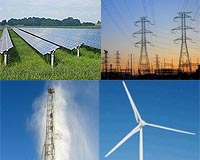 |
Canberra, Australia (UPI) Oct 1, 2009 Australia today announced a $100 million plan for the country's first commercial-scale "smart" grid to deliver electricity. The "Smart Grid, Smart City" initiative will be a cooperative effort between the Australian government and the energy and communications sectors. The program has the potential to reduce home energy bills, reduce carbon pollution and help tackle climate change, the government says. Australia has surpassed the United States as the world's biggest per capita producer of carbon emissions. "From the power plant to the power point, smart grids enable a two-way flow of information between energy suppliers and consumers," Environment Minister Peter Garrett said in a release. "Linking all these energy data points creates a web of information so that energy can be delivered where and when it is required. The potential economic benefits of creating an Internet for the energy industry are staggering." The announcement comes in conjunction with the completion of a two-month study commissioned by the government -- "Smart Grid, Smart City: A New Direction for a New Energy Era" -- on how smart grids can optimally work in Australia. A target date for the plan was not disclosed. "With this $100 million investment, Australia will showcase the world's best practice when it comes to investing in smart grid technologies, helping industry get on with the job of rolling out these technologies and supporting clean energy jobs," Garrett said. Smart grids interact with information technology and communications infrastructures using two-way digital communications to deliver electricity. They help energy suppliers to better manage peak loads, reduce the risk of blackouts during peak-use periods and improve the reliability of electricity supply. Renewable energies can also be incorporated into the grid. Australia's minister for resources and energy, Martin Ferguson, said the rollout of a smart grid -- which uses two-way digital communications to deliver electricity -- will provide Australia with more reliable energy delivery, allow consumers to sell power back into the grid and ideally will cut costs and greenhouse gas emissions. According to Access Economics, if Australia were to invest $3.2 billion in smart grid technology over five years, electricity use would decrease by 4 percent and the country's gross domestic product could increase by up to $16 billion over 10 years. The move could also create nearly 18,000 new jobs. Australia has the potential to become a world leader in deploying smart grid technology, but the country will need to deal with any regulatory barriers, consider possible tax incentives as well as invest in research and development, Guido Bartels, IBM's global energy and utilities general manager, said at a Melbourne energy conference in September. Share This Article With Planet Earth
Related Links Powering The World in the 21st Century at Energy-Daily.com
 China, US must lead on clean energy: US official
China, US must lead on clean energy: US officialBeijing (AFP) Sept 30, 2009 China and the United States can help lead global efforts to fight climate change by pushing each other to invest more in cutting-edge clean energy technology, a top US official said Wednesday. Assistant Secretary of Energy David Sandalow, speaking at the end of a trip to China, said the issue would figure prominently in discussions when US President Barack Obama visits Beijing in November. ... read more |
|
| The content herein, unless otherwise known to be public domain, are Copyright 1995-2009 - SpaceDaily. AFP and UPI Wire Stories are copyright Agence France-Presse and United Press International. ESA Portal Reports are copyright European Space Agency. All NASA sourced material is public domain. Additional copyrights may apply in whole or part to other bona fide parties. Advertising does not imply endorsement,agreement or approval of any opinions, statements or information provided by SpaceDaily on any Web page published or hosted by SpaceDaily. Privacy Statement |